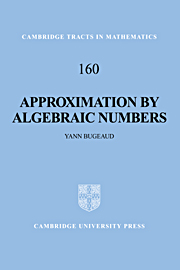Book contents
- Frontmatter
- Contents
- Preface
- Frequently used notation
- 1 Approximation by rational numbers
- 2 Approximation to algebraic numbers
- 3 The classifications of Mahler and Koksma
- 4 Mahler's Conjecture on S-numbers
- 5 Hausdorff dimension of exceptional sets
- 6 Deeper results on the measure of exceptional sets
- 7 On T-numbers and U-numbers
- 8 Other classifications of real and complex numbers
- 9 Approximation in other fields
- 10 Conjectures and open questions
- Appendix A Lemmas on polynomials
- Appendix B Geometry of numbers
- References
- Index
3 - The classifications of Mahler and Koksma
Published online by Cambridge University Press: 12 August 2009
- Frontmatter
- Contents
- Preface
- Frequently used notation
- 1 Approximation by rational numbers
- 2 Approximation to algebraic numbers
- 3 The classifications of Mahler and Koksma
- 4 Mahler's Conjecture on S-numbers
- 5 Hausdorff dimension of exceptional sets
- 6 Deeper results on the measure of exceptional sets
- 7 On T-numbers and U-numbers
- 8 Other classifications of real and complex numbers
- 9 Approximation in other fields
- 10 Conjectures and open questions
- Appendix A Lemmas on polynomials
- Appendix B Geometry of numbers
- References
- Index
Summary
The set of real numbers splits into algebraic and transcendental numbers, but these two subsets do not have the same size, the former being countable, while the latter has the power of continuum. Such a crude classification of real numbers seems to be rather unsatisfactory, and one aims to find some way to classify the transcendental numbers. First, we have to ask which requirements should satisfy a ‘good’ classification. Ideally, for a given real number ξ, we would like to have a simple criterion to determine the class to which ξ belongs. Furthermore, two algebraically dependent real numbers should belong to the same class. The first classification of transcendental real numbers has been proposed by Maillet [403, 404], and others were subsequently described by Perna [453] and by Morduchai-Boltovskoj [430], but none of these has proved to be relevant. For instance, Maillet's classification depends on the size of the partial quotients of the real numbers and, clearly, does not satisfy the second requirement.
An attempt towards a ‘reasonable’ classification was made in 1932 by Mahler [376], who proposed to subdivide the set of real numbers into four classes (including the class of algebraic numbers) according to, roughly speaking, their properties of approximation by algebraic numbers. Mahler's classification satisfies our second requirement: two algebraically dependent real numbers belong to the same class.
- Type
- Chapter
- Information
- Approximation by Algebraic Numbers , pp. 41 - 73Publisher: Cambridge University PressPrint publication year: 2004

